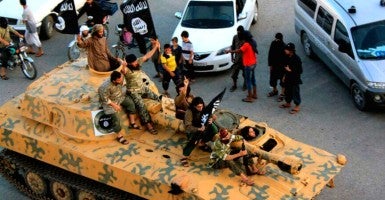The Islamic State (ISIS) has previously taken manpower, territory, and funds from al-Qaeda. Now it is taking its instruction books.
A story in London’s Daily Telegraph highlights that ISIS has commandeered and then updated a publication released by al-Fajr Media Center (al-Qaeda’s online distributor) called “Safety and security guidelines for lone wolf mujahideen and small cells.” ISIS has simply updated it to provide up-to-date advice for jihadis living in the West.
With that being the case, some of the instructions are familiar: shaving off beards, wearing Western clothes, how to structure a terrorist cell. ISIS also gives its followers permission to wear a cross in order to throw others off their scent.
The document also discusses the importance of encrypting communications. While that is not entirely new, it does reflect jihadists’ Edward Snowden-inspired recognition that they needed to get smarter in this area in order to avoid detection. Indeed, the group recently created its own secure messaging app for precisely this reason.
“Safety and security guidelines for lone wolf mujahideen and small cells” also has a specific focus on “lone wolves.” Such operators tend to plan crude attacks using knives and guns, with the police and military commonly targeted.
The ISIS-inspired shooting of a policeman in Philadelphia is an example of this (although questions do remain about the extent to which the shooter, Edward Archer, was part of a larger network). Such plots require much less planning than 9/11-style “spectaculars” and are therefore much harder for authorities to stop. Clearly, ISIS believes that it is this type of attack that its Western supporters have the best chance of pulling off in volume.
Yet it is important to remember that “lone wolves” are by no means the only game in town for ISIS. In Europe, for example, “lone wolves” are just one element of ISIS’ plans. Events in Paris (and, almost, Verviers in Belgium, where an imminent major plot was disrupted) in the last twelve months prove that ISIS is capable of infiltrating Europe and then hitting it hard with complex, coordinated terrorist attacks.
With this being the case, “Safety and security guidelines for lone wolf mujahideen and small cells” will likely be especially useful for an American audience, a country that ISIS has found it harder to infiltrate and where its options are more limited. Its best hope of attacking America is by inspiring sympathizers living there already. That is why this type of material—be it produced by al-Qaeda or ISIS—is potentially so dangerous.




























